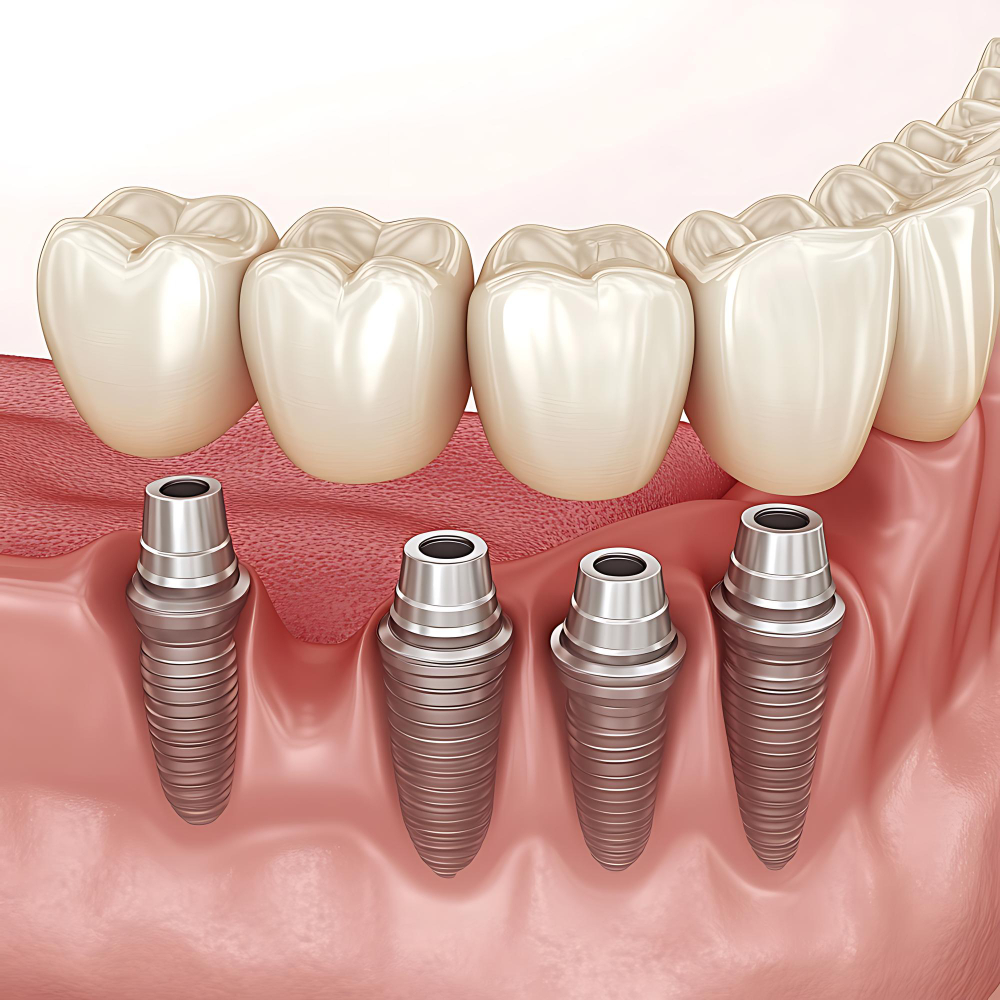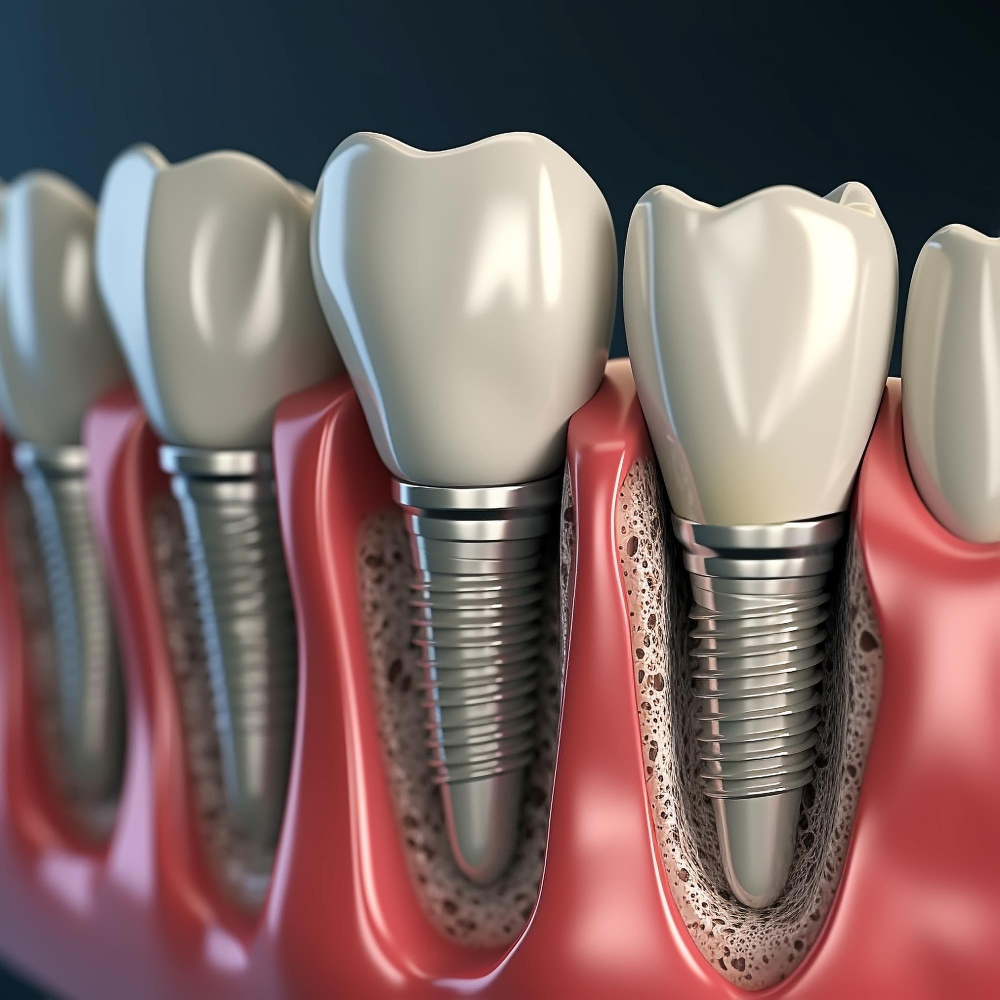Introduction to All-on-4 Dental Implants
All-on-4 dental implants represent a revolutionary method in the realm of dental restorations, offering a comprehensive solution for patients requiring full-arch teeth replacement. Unlike traditional dental implants, which typically involve the placement of an individual implant for each missing tooth, the All-on-4 technique uses just four strategically placed implants to support a full dental arch. This innovative approach is designed to provide a stable and durable foundation for prosthetic teeth, ensuring enhanced comfort and functionality.
The principal distinction between All-on-4 dental implants and their conventional counterparts lies in their minimally invasive nature and the efficiency of the procedure. Traditional implants often necessitate bone grafts and multiple surgeries, extending the treatment timeline. Conversely, All-on-4 implants can frequently bypass the need for bone grafting due to their optimized angulation and placement, which utilizes available bone more efficiently. This results in a significantly shorter treatment and recovery period, which is one of the core reasons for its growing popularity among patients and clinicians alike.
Among the key benefits of All-on-4 dental implants is the immediate functionality they offer. Patients can often receive temporary, but fully functional, teeth on the same day as their implant surgery, thereby minimizing the period of toothlessness. Additionally, this method boasts high success rates and requires fewer implants overall, resulting in a cost-effective solution for those seeking comprehensive dental restoration. The All-on-4 system is known for its ability to enhance the patient’s quality of life, improving both aesthetics and overall oral health.
The increasing popularity of All-on-4 dental implants can be attributed to their efficiency, effectiveness, and the significant improvements they bring to patients’ dental health. Dental professionals advocate this method because it not only caters to patients’ need for a swift and lasting solution but also integrates seamlessly with modern surgical techniques and prosthetic innovations.
How All-on-4 Dental Implants Work
All-on-4 dental implants represent a revolutionary solution in tooth replacement technology, designed to provide patients with a full set of permanent, fixed teeth. The procedure involves placing four strategically positioned implants in the upper or lower jawbone to support an entire arch of artificial teeth. This method not only maximizes the use of available bone but also minimizes the need for bone grafts, which can often be required in other implant procedures.
The process begins with a comprehensive consultation, where detailed imaging and 3D scans of the jaw are taken. This allows the dental surgeon to plan the precise placement of the implants. During the surgery, two of the implants are placed in the anterior (front) part of the jaw, and two are placed at an angle in the posterior (back) to ensure maximum stability and support for the dental arch.
Once the implants are securely in place, a temporary set of teeth is typically attached. This allows the patient to start using their new teeth immediately while the implants undergo osseointegration—a process where the bone grows around the implants, anchoring them firmly in place. Over a period of three to six months, this bonding ensures the implants become a permanent part of the mouth’s structure.
The arch in the All-on-4 system is crucial as it distributes the chewing pressure evenly across all four implants. This reduces the risk of implant failure and ensures greater comfort and functionality compared to traditional dentures. The simultaneous engagement of both anterior and posterior implants allows for a balanced force distribution, mimicking the natural bite and chew pattern found in a healthy mouth.
Ultimately, All-on-4 dental implants offer a durable and cost-effective solution for those seeking a full-arch restoration. By leveraging advanced techniques and strategic implant placement, this method promises a significant improvement in quality of life for persons with missing teeth.
Candidate Eligibility for All-on-4 Dental Implants
Selecting appropriate candidates for All-on-4 dental implants requires a comprehensive evaluation of various physiological and healthcare factors. Primarily, potential candidates must have sufficient bone density in their jaw to support the implants. The All-on-4 technique utilizes just four implants to anchor a full arch of teeth, making bone quality and quantity critically important for the procedure’s success.
Gum health is another pivotal consideration. Healthy gums are essential as they provide the necessary support and recovery environment for the implants. Patients with periodontal disease or severe gum infections must undergo treatment to stabilize their oral health before becoming viable candidates for All-on-4 implants.
Additionally, good oral hygiene habits significantly impact the long-term success of All-on-4 dental implants. Regular brushing, flossing, and dental check-ups can prevent infections and ensure the longevity of the implants. Dentists often emphasize the importance of maintaining excellent oral hygiene practices before, during, and after the implant procedure.
Overall health considerations cannot be ignored. Chronic conditions such as diabetes, heart disease, or immunodeficiency disorders may affect the healing process post-surgery. Thus, candidates are thoroughly assessed for any medical conditions that could compromise the success of dental implants.
The pre-implant evaluation process involves several critical steps to ensure candidate suitability. Initially, a detailed consultation helps gather medical history and discuss patient expectations. Following this, precise examinations such as CT scans are performed to assess bone structure, and dental impressions are taken to create accurate models of the patient’s mouth. These assessments enable dental professionals to devise a customized treatment plan, ensuring the utmost precision and care in the implant process.
The Benefits of All-on-4 Dental Implants
All-on-4 dental implants provide a revolutionary solution for individuals with missing teeth, offering numerous advantages over traditional dental restoration methods. One of the most significant benefits is the reduced recovery time. Unlike conventional implants that may require several visits and prolonged healing periods, All-on-4 implants are designed to provide immediate functionality. This is achieved through a streamlined process that uses only four strategically placed implants per arch, reducing the overall complexity and time involved.
Another key advantage is the fewer implants needed. Traditional full arch restorations may require up to eight implants. The All-on-4 technique, however, efficiently supports a full set of teeth using just four implants, making the procedure less invasive and less time-consuming. This reduction in the number of implants also contributes to cost efficiency, as fewer materials and surgeries generally translate to lower overall expenses.
In terms of functional benefits, All-on-4 dental implants significantly improve oral function. Patients experience a stable and secure fit for their prosthetic teeth, allowing them to eat, speak, and smile confidently without the fear of their dentures slipping. This stability also contributes to enhanced aesthetics, as the implants provide a natural-looking appearance that blends seamlessly with existing facial structures.
Moreover, All-on-4 dental implants are known for their long-term durability. The use of high-quality materials and advanced surgical techniques ensures that these implants can withstand the rigors of daily use for many years. This durability not only offers peace of mind but also results in a higher return on investment for patients over time.
Overall, the All-on-4 technique stands out for its comprehensive benefits, making it an appealing option for those seeking a reliable, efficient, and aesthetically pleasing solution to tooth loss. Whether it’s the streamlined procedure, cost savings, enhanced oral function, or the natural look, All-on-4 dental implants provide a superior alternative to traditional dental restoration methods.
The All-on-4 Procedure: Step-by-Step
The All-on-4 dental implant procedure is a transformative approach designed to restore full dental function and aesthetics with minimal invasiveness. Understanding each stage of the process ensures clarity for candidates considering this option.
Preliminary Evaluations
The journey begins with comprehensive preliminary evaluations. During the initial consultation, your dental specialist will conduct a thorough assessment of your oral health. This involves examining your dental history, taking X-rays, and performing a CT scan to analyze bone structure and density, ensuring a suitable foundation for the implants. These assessments are crucial for tailoring a customized treatment plan that addresses your specific needs.
Anesthesia
On the day of the procedure, the next significant step is the administration of anesthesia. This is crucial to ensure comfort and a pain-free experience throughout the surgery. Depending on the case’s complexity and the patient’s preference, local anesthesia, sedation, or general anesthesia options may be utilized.
Extractions (If Necessary)
In cases where existing teeth are decayed or compromised, extractions may be necessary. Your dental surgeon will carefully remove these teeth to prepare the mouth for the implants. This step is conducted with precision to minimize trauma and facilitate quicker healing.
Implant Insertion
Following extractions, the primary step involves inserting the implants. The All-on-4 technique involves strategically placing four dental implants into the jawbone. These implants serve as the new roots for the prosthetic teeth. The posterior implants are typically placed at an angle to maximize bone use, providing a stable and robust foundation.
Temporary Prosthesis Fitting
Immediately after implant insertion, a temporary prosthesis is fitted. This allows patients to leave the clinic with functional teeth on the same day. The temporary denture promotes healing of the gums and ensures that implants are securely positioned.
Final Placement of the Permanent Prosthesis
The final stage occurs a few months post-surgery, allowing time for osseointegration—the process where the bone grows around the implants, securing them in place. Once this healing phase is complete, the temporary prosthesis is replaced with a custom-made permanent set of teeth. These permanent prostheses are designed for durability, functionality, and a natural appearance, seamlessly blending with your existing oral structures.
The entire All-on-4 procedure is a methodically planned and executed process, offering patients a reliable and long-lasting solution for missing teeth.
Recovery and Aftercare for All-on-4 Dental Implants
The recovery process following an All-on-4 dental implant procedure is crucial for ensuring successful integration and long-term stability of the implants. Immediately after surgery, patients can expect some discomfort, swelling, and minor bleeding. These side effects usually subside within a few days, but it is essential to follow your dentist’s post-operative instructions to mitigate any complications.
The initial 72 hours are critical for the healing process. During this period, it is advisable to rest adequately and avoid strenuous activities. Swelling can be managed with the use of cold compresses and prescribed medications. Pain can typically be controlled with over-the-counter pain relievers, though stronger prescriptions may be provided in certain cases.
Within the first week, it is common to experience minor swelling and bruising. Maintaining a soft-food diet is recommended to avoid any unnecessary pressure on the new implants. Foods such as yogurt, mashed potatoes, and smoothies are ideal. Gradually, patients can reintroduce more solid foods as comfort levels improve, although chewy or hard foods should be avoided for several weeks.
Oral hygiene is paramount during the recovery phase. Gentle brushing of the surrounding teeth and implants with a soft-bristled toothbrush and non-abrasive toothpaste will help prevent infection. An antibacterial mouthwash is also beneficial in controlling any potential bacterial growth. It’s important to be cautious around the surgical sites to avoid causing any disruptions to the healing tissue.
Regular follow-up visits with your dentist are integral to monitor the progress of the healing process and to ensure that the implants are integrating well with the bone. These visits provide an opportunity to address any concerns or complications that might arise, such as infections or improper alignment.
By adhering to these aftercare guidelines, patients can significantly improve their chances of a smooth recovery and enjoy the benefits of their All-on-4 dental implants for many years to come. Proper care and a committed oral hygiene routine are keys to maximizing the lifespan and functionality of the implants.
Comparing All-on-4 with Other Dental Implant Options
When considering tooth replacement options, All-on-4 dental implants offer a unique and advantageous approach compared to traditional dentures and other dental implant techniques. One of the most significant benefits of the All-on-4 method is the level of comfort it provides. Unlike traditional dentures, which can be cumbersome and require adhesives to stay in place, All-on-4 implants are anchored securely into the jawbone, offering a stable and comfortable fit that feels more natural.
The cost of All-on-4 implants is another critical factor for patients to consider. While the upfront cost may be higher than traditional dentures, it is essential to weigh this against the long-term benefits. Traditional dentures often require replacement and ongoing maintenance, while All-on-4 implants are designed to be a permanent solution with less frequent need for adjustments, potentially reducing long-term expenses.
Appearance is another area where All-on-4 implants shine. These implants provide a more natural and aesthetically pleasing look compared to traditional dentures. The implant-supported prosthesis closely imitates the appearance of natural teeth and gums, contributing to a fuller, more youthful facial structure. This advantage is particularly appealing for patients concerned about the visible aspects of their dental restoration.
Maintenance is simplified with All-on-4 implants. Routine dental hygiene practices such as brushing and flossing suffice, whereas traditional dentures often require special cleaning solutions and regular adjustments. This ease of maintenance can be a deciding factor for individuals looking for a more straightforward approach to ongoing dental care.
When assessing long-term success rates, the All-on-4 technique demonstrates impressive durability and functionality. Studies indicate that these implants have a high success rate over the years, providing reliable performance and patient satisfaction. However, it is important to acknowledge some potential drawbacks. The surgical procedure for All-on-4 implants may not be suitable for everyone, particularly individuals with certain medical conditions or insufficient bone density in the jaw.
In summary, while each dental replacement option has its pros and cons, All-on-4 dental implants offer a compelling combination of comfort, aesthetic appeal, ease of maintenance, and strong long-term success rates. Carefully consulting with a dental professional can help determine the most appropriate solution tailored to individual needs and circumstances.
Success Rates and Longevity of All-on-4 Dental Implants
All-on-4 dental implants have garnered significant attention due to their high success rates and long-term viability. Various studies and clinical research have substantiated the reliability of this implant system. According to a comprehensive review conducted by the Journal of Clinical Periodontology, the cumulative survival rate for All-on-4 implants exceeds 98% over a period of ten years. This high success rate can be attributed to the innovative design and meticulous surgical protocols employed during the implant procedure.
Several factors contribute to the durability and success of All-on-4 dental implants. Primarily, the strategic placement of four implants in the jawbone ensures optimal support and distribution of occlusal forces. Additionally, the use of high-quality biocompatible materials like titanium enhances the osseointegration process, where the implant fuses naturally with the bone. This solid integration significantly reduces the risk of implant failure.
Nonetheless, the longevity of All-on-4 dental implants is also influenced by patient-specific factors. Good oral hygiene, regular dental check-ups, and adherence to post-operative instructions are crucial for maintaining the health of the implants. Patients with systemic conditions such as diabetes or those who smoke may face challenges impacting the success and longevity of their implants. Therefore, it is imperative to address and manage these conditions effectively before and after the implant procedure.
Real-life case studies further highlight the enduring nature of All-on-4 dental implants. For instance, a 55-year-old patient reported high levels of satisfaction and functionality with their All-on-4 implants twelve years post-procedure. This testimonial aligns with clinical research, affirming that with proper care, All-on-4 implants can serve as a long-lasting solution for individuals seeking comprehensive dental rehabilitation.
In summary, the All-on-4 dental implant system stands out for its impressive success rates and longevity. While procedural excellence and material quality play pivotal roles, patient cooperation in maintaining oral health is equally essential to ensure the sustained success of the implants.









